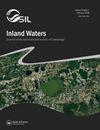Imperfect slope measurements drive overestimation in a geometric cone model of lake and reservoir depth
IF 2.3
3区 环境科学与生态学
Q1 LIMNOLOGY
引用次数: 3
Abstract
ABSTRACT Lake and reservoir (waterbody) depth is a critical characteristic that influences many important ecological processes. Unfortunately, depth measurements are labor-intensive to gather and are only available for a small fraction of waterbodies globally. Therefore, scientists have tried to predict depth from characteristics easily obtained for all waterbodies, such as surface area or the slope of the surrounding land. One approach for predicting waterbody depth simulates basins using a geometric cone model where the nearshore land slope and distance to the center of the waterbody are assumed to be representative proxies for in-lake slope and distance to the deepest point respectively. We tested these assumptions using bathymetry data from ∼5000 lakes and reservoirs to examine whether differences in waterbody type or shape influenced depth prediction error. We found that nearshore land slope was not representative of in-lake slope, and using it for prediction increases error substantially relative to models using true in-lake slope for all waterbody types and shapes. Predictions were biased toward overprediction in concave waterbodies (i.e., bowl-shaped; up to 18% of the study population) and reservoir waterbodies (up to 30% of the study population). Despite this systematic overprediction, model errors were fewer (in absolute and relative terms, irrespective of any specific slope covariate) for concave than convex waterbodies, suggesting the geometric cone model is an adequate representation of depth for these waterbodies. But because convex waterbodies are far more common (>72% of our study population), minimizing overall depth prediction error remains a challenge.不完善的坡度测量导致湖泊和水库深度几何锥模型的高估
摘要湖泊和水库(水体)深度是影响许多重要生态过程的关键特征。不幸的是,深度测量需要耗费大量人力才能收集,而且只适用于全球一小部分水体。因此,科学家们试图根据所有水体的特征来预测深度,例如地表面积或周围土地的坡度。一种预测水体深度的方法使用几何锥模型模拟流域,其中假设近岸陆地坡度和到水体中心的距离分别是湖内坡度和到最深点的距离的代表性指标。我们使用约5000个湖泊和水库的测深数据测试了这些假设,以检查水体类型或形状的差异是否影响深度预测误差。我们发现,近岸陆坡并不能代表湖内陆坡,使用它进行预测会大大增加误差,与使用所有水体类型和形状的真实湖内陆坡模型相比。预测偏向于凹形水体(即碗状;高达研究人群的18%)和水库水体(高达研究群体的30%)的过度预测。尽管存在这种系统性的过度预测,但凹水体的模型误差(无论任何特定的斜率协变量如何,都是绝对和相对的)比凸水体的模型错误少,这表明几何锥模型是这些水体深度的充分表示。但由于凸水体更为常见(占我们研究人群的72%以上),最大限度地减少整体深度预测误差仍然是一个挑战。
本文章由计算机程序翻译,如有差异,请以英文原文为准。
求助全文
约1分钟内获得全文
求助全文
来源期刊

Inland Waters
LIMNOLOGY-MARINE & FRESHWATER BIOLOGY
CiteScore
6.10
自引率
9.70%
发文量
34
审稿时长
>12 weeks
期刊介绍:
Inland Waters is the peer-reviewed, scholarly outlet for original papers that advance science within the framework of the International Society of Limnology (SIL). The journal promotes understanding of inland aquatic ecosystems and their management. Subject matter parallels the content of SIL Congresses, and submissions based on presentations are encouraged.
All aspects of physical, chemical, and biological limnology are appropriate, as are papers on applied and regional limnology. The journal also aims to publish articles resulting from plenary lectures presented at SIL Congresses and occasional synthesis articles, as well as issues dedicated to a particular theme, specific water body, or aquatic ecosystem in a geographical area. Publication in the journal is not restricted to SIL members.
 求助内容:
求助内容: 应助结果提醒方式:
应助结果提醒方式:


